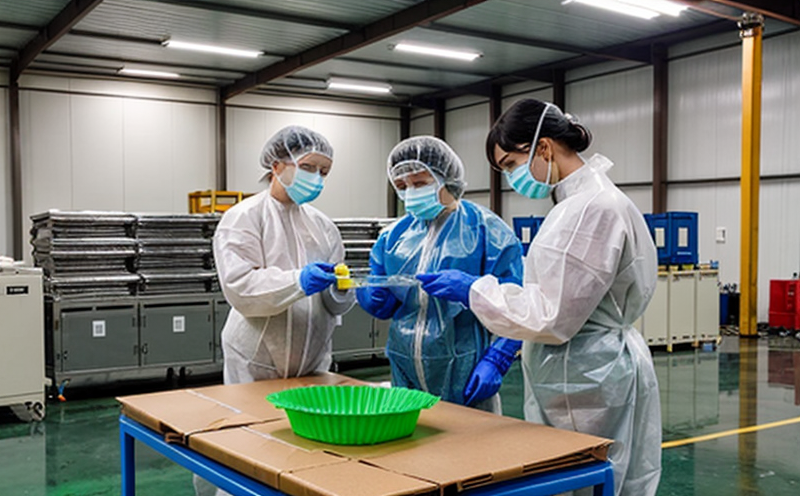ASTM D790-10 Flexural Modulus Testing
The ASTM D790-10 flexural modulus test is a critical procedure used in the packaging testing sector to determine the resistance of plastic materials to bending. This test is essential for quality assurance and compliance with international standards, ensuring that plastic packaging meets rigorous mechanical performance requirements.
Flexural modulus, often referred to as Young’s modulus in the context of bending stress, measures a material's stiffness under load. In plastic packaging testing, this value indicates how much a given sample will bend before it breaks or deforms permanently. The test is particularly important for ensuring that packaging materials maintain their integrity during handling, shipping, and storage.
The ASTM D790-10 standard specifies the dimensions of rectangular specimens used in flexural testing. These specimens are typically prepared from the plastic material to be tested, cut to standardized sizes, and conditioned under controlled environmental conditions before testing. The test involves applying a load at a constant rate until failure or deflection is observed.
The results of the ASTM D790-10 flexural modulus test provide valuable insights into the mechanical properties of plastic packaging materials. This information helps quality managers and compliance officers ensure that the products meet regulatory requirements and perform reliably under expected conditions. The test also aids in the research and development (R&D) process by providing data on how changes in material composition or processing affect the mechanical performance.
| Parameter | Description |
|---|---|
| Test Specimen Dimensions | Rectangular cross-section, 12.5 mm x 12.5 mm x L (length) = 50 mm ± 0.5 mm. |
| Testing Machine | Universal testing machine with a capacity of at least five times the expected breaking load. |
| Loading Rate | 1 mm/min ± 0.5 mm/min. |
| Test Setup | Specimen is supported at two points and loaded in the middle until failure or deflection. |
The test setup involves attaching the specimen to a universal testing machine, ensuring it is securely held. The load is then applied at a constant rate, typically 1 mm per minute. As the load increases, the specimen bends until it either breaks or reaches a specified deflection point.
Understanding the flexural modulus of plastic packaging materials is crucial for several reasons:
- To ensure that the material can withstand the mechanical stresses encountered during manufacturing and distribution.
- To optimize design by selecting appropriate materials for different applications, ensuring both cost-effectiveness and performance.
- To meet regulatory requirements set forth in standards like ASTM D790-10.
Quality and Reliability Assurance
The ASTM D790-10 flexural modulus test plays a vital role in the quality control processes of plastic packaging manufacturers. By regularly performing this test, companies can ensure that their products consistently meet or exceed industry standards.
- Consistency: The test helps maintain consistent material properties across production runs by providing repeatable results.
- Compliance: It ensures adherence to international and national regulations, such as those outlined in ASTM D790-10.
- Prediction of Performance: Understanding the flexural modulus helps predict how a material will perform under real-world conditions.
The test is also used during product development to refine materials and processes. Engineers can use the results from ASTM D790-10 tests to identify areas for improvement, such as enhancing flexibility or increasing strength without sacrificing other important properties like transparency or printability.
Environmental and Sustainability Contributions
The ASTM D790-10 flexural modulus test can contribute positively to environmental sustainability efforts. By ensuring that plastic packaging materials are robust yet lightweight, manufacturers can reduce the overall weight of packaging without compromising its protective function.
- Reduced Waste: Lightweight and durable materials lead to less waste in production and disposal phases.
- Eco-Friendly Materials: Understanding material properties helps in selecting eco-friendly alternatives that are both sustainable and perform well.
- Energy Efficiency: Optimizing packaging reduces the need for additional protective measures, which can lead to lower energy consumption throughout the supply chain.
Moreover, the test results from ASTM D790-10 can guide efforts towards designing more sustainable packaging solutions. This includes using recycled materials or biodegradable options that meet strict mechanical performance standards without compromising safety or functionality.
Use Cases and Application Examples
- Pallet Wraps: Ensuring that pallet wraps have the necessary flexibility to conform around various shapes while maintaining tensile strength during handling.
- Bottle Caps: Testing bottle caps for their resistance to bending and eventual failure, which is crucial for preventing leaks or contamination.
- Polyethylene Terephthalate (PET) Bottles: Evaluating the flexural properties of PET bottles to ensure they are robust enough to withstand stacking in warehouses without cracking.
| Material Type | Purpose of Test |
|---|---|
| Polystyrene (PS) | Evaluating the rigidity and heat resistance for trays, containers. |
| Polyvinyl Chloride (PVC) | Assessing flexibility and durability in hoses, pipes. |
| Polyethylene (PE) | Testing the strength of films, sheets for packaging. |
The ASTM D790-10 flexural modulus test is widely used in industries such as food and beverage, pharmaceuticals, and consumer goods. By applying this test to different plastic materials, manufacturers can ensure that their products are safe, durable, and environmentally friendly.





